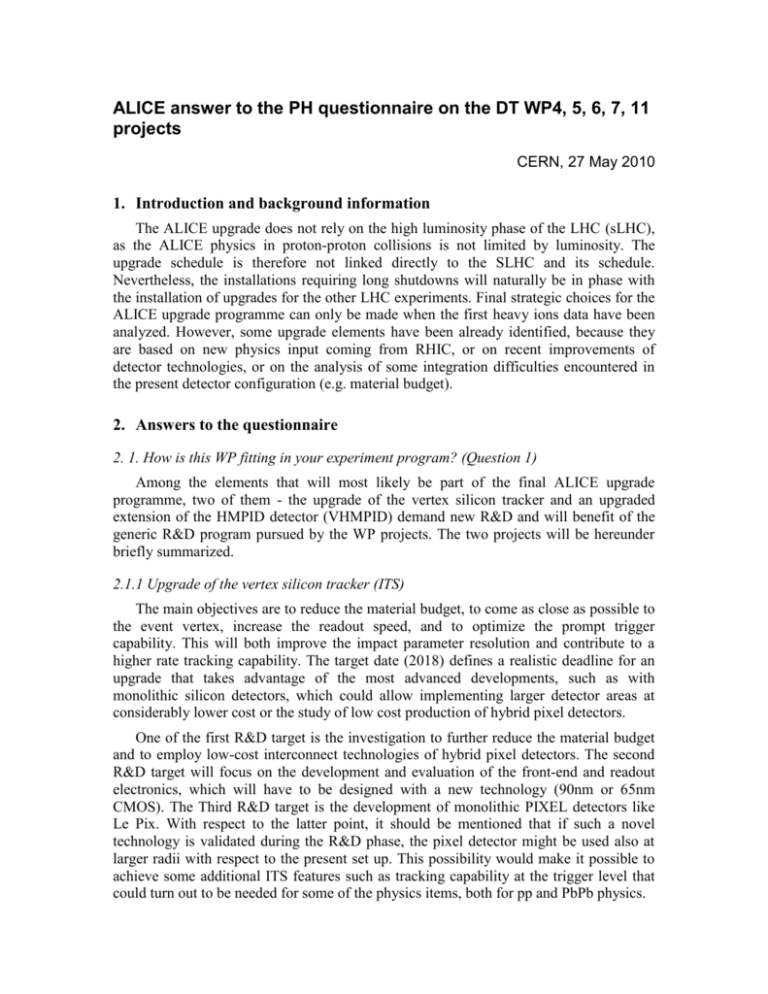1) How is this WP fitting in your experiment program - Indico
advertisement

ALICE answer to the PH questionnaire on the DT WP4, 5, 6, 7, 11 projects CERN, 27 May 2010 1. Introduction and background information The ALICE upgrade does not rely on the high luminosity phase of the LHC (sLHC), as the ALICE physics in proton-proton collisions is not limited by luminosity. The upgrade schedule is therefore not linked directly to the SLHC and its schedule. Nevertheless, the installations requiring long shutdowns will naturally be in phase with the installation of upgrades for the other LHC experiments. Final strategic choices for the ALICE upgrade programme can only be made when the first heavy ions data have been analyzed. However, some upgrade elements have been already identified, because they are based on new physics input coming from RHIC, or on recent improvements of detector technologies, or on the analysis of some integration difficulties encountered in the present detector configuration (e.g. material budget). 2. Answers to the questionnaire 2. 1. How is this WP fitting in your experiment program? (Question 1) Among the elements that will most likely be part of the final ALICE upgrade programme, two of them - the upgrade of the vertex silicon tracker and an upgraded extension of the HMPID detector (VHMPID) demand new R&D and will benefit of the generic R&D program pursued by the WP projects. The two projects will be hereunder briefly summarized. 2.1.1 Upgrade of the vertex silicon tracker (ITS) The main objectives are to reduce the material budget, to come as close as possible to the event vertex, increase the readout speed, and to optimize the prompt trigger capability. This will both improve the impact parameter resolution and contribute to a higher rate tracking capability. The target date (2018) defines a realistic deadline for an upgrade that takes advantage of the most advanced developments, such as with monolithic silicon detectors, which could allow implementing larger detector areas at considerably lower cost or the study of low cost production of hybrid pixel detectors. One of the first R&D target is the investigation to further reduce the material budget and to employ low-cost interconnect technologies of hybrid pixel detectors. The second R&D target will focus on the development and evaluation of the front-end and readout electronics, which will have to be designed with a new technology (90nm or 65nm CMOS). The Third R&D target is the development of monolithic PIXEL detectors like Le Pix. With respect to the latter point, it should be mentioned that if such a novel technology is validated during the R&D phase, the pixel detector might be used also at larger radii with respect to the present set up. This possibility would make it possible to achieve some additional ITS features such as tracking capability at the trigger level that could turn out to be needed for some of the physics items, both for pp and PbPb physics. 2.1.2 Upgraded extension of the HMPID detector -- VHMPID It is proposed to investigate the suitability of a Very High Momentum Particle Identification Detector (VHMPID), based on RICH (Ring Imaging Cherenkov) technique using a gaseous C4F10 radiator, coupled via a spherical mirror in a focusing geometry to a CsI-based photon detector, for charged hadrons identification on a track-by-track basis in the 10 < p < 25 GeV/c momentum range. One wants to make use, as much as possible, of the innovative technology developed at CERN for the present HMPID detector in order to reduce the cost of the upgrade. The possibility of replacing the MWPC with a thick GEM detector will be investigated during the R&D phase. The current planning foresees the construction and testbeam verifications of a small prototype detector during 2010 and 2011 and the installation of a full size prototype module in ALICE in the 2012 shutdown. The approval of the full project will be decided on the results of this test and the implementation in ALICE would happen in shutdowns after 2014. 2.1.3 Relevance of the WP a) WP4 – Radiation Hard Semiconductor Detectors, RD50 The test equipment & infrastructure for PH common use will be extremely useful and valuable for evaluation of the novel sensor technologies that ALICE is investigating. We expect this to become a PH-DT service after 2011. Radiation hardness is however not an issue for the ALICE tracker upgrade. b) WP5 – Micropattern Gas Detectors, RD51 The R&D for VHMPID includes the idea of using CsI coated thick GEMs. ALICE is very interested in the “development of large UV photon detectors for RICH applications based on THGEM technology”. The related GARFIELD model refinements for electron transport and field calculations are therefore also interesting. The ALICE detector is making heavy use of gaseous detectors (TPC, TRD, HMPID, TOF, Muon Tracking, Muon Trigger). We assume that the maintenance of the GARFIELD versions applicable to wire chambers is guaranteed beyond 2011. c) WP6 – Quality Control, Interconnect Technologies As mentioned in the comment to WP4 we are interested in the infrastructure (test equipment) and expertise (trained personnel) to apply QA and Reliability Testing for the upgrade R&D and construction, and we expect that it will become a DT-PH service beyond 2011. d) WP7 – Material Studies, Irradiation Facilities The ALICE RPC detectors (TOF and Muon Trigger) were all extensively tested in the GIF facility in the past. While the currently known upgrade projects do not foresee detector tests in GIF, the need for irradiation tests of some detector components will almost certainly arise during the ALICE operation in the next years. We assume that this will become a PH or general CERN facility after 2011. The materials database and RPC gas system studies are interesting but not of prime importance for ALICE. e) WP11 – Detector Cooling This development is very relevant for the ALICE tracker upgrade project, where the efficient removal of heat with minimum amount of material is a key feature. ALICE is using a C4F10 evaporative cooling for the Pixel detector, so naturally there is a strong interest in following investigations and developments of evaporative cooling systems based on µ-channel technology. 2.2 Are the deliverables expected end of 2011 meeting your requirements? (Question 2) If yes, how many of these deliverables should be available and when and what else are you expecting (production, integration, ...)? If not, what are the extra developments needed and in which time scale? The VHMPID project will make the choice of wire chambers vs. GEM detectors before the end of 2011, which matches with the outlined RD51 activities. . 2.3 Which resources are you able to inject in that particular project either to reach completion of new requirements or to customize or to integrate? With which time scale? (Question 3) ALICE is currently contributing to the RD51 project with two people: Hans Muller for the RD51 readout system and Vladimir Peskov for the thick GEM UV photon detectors. Their participation will not continue beyond 2011. Concerning the development of common readout electronics and portable DAQ system, ALICE has already asked RD51 to find an institute to provide support for the RD51 collaboration starting in 2010. Concerning the detector cooling project, ALICE people are following closely this develoment in the context of the NA62 Giga tracker project. 2.4 How do you see the long term future (beyond 2011) of this WP ?(e.g. extension, reduction, re-focus, conversion to service, absorption in experiment specific projects, …) (Question 4) The WP activities that ALICE is interested in all fall in the category, which we hope to become PH service or a PH core activity after 2011.







